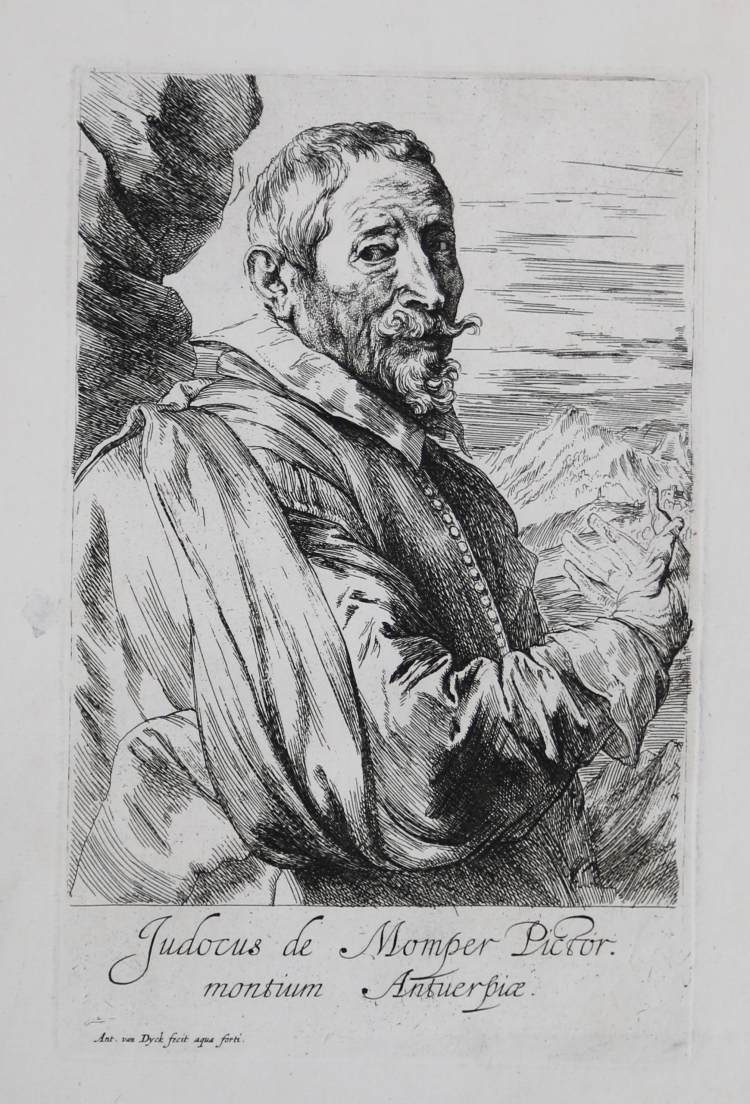




| Reference: | S39603 |
| Author | Anton van DYCK |
| Year: | 1630 ca. |
| Measures: | 157 x 242 mm |



| Reference: | S39603 |
| Author | Anton van DYCK |
| Year: | 1630 ca. |
| Measures: | 157 x 242 mm |
Etching, circa 1630-40, lettered below the portrait, in two lines of Latin: "Judocus de Momper Pictor / montium Antverpiæ". Signed in lower margin left: "Ant. van Dyck fecit aqua forti".
Portrait of Joos de Momper, half-length in front of a rocky overhang, turned to the right but looking towards the viewer; with short hair, moustache and beard, wearing a collar, buttoned doublet and cloak, his gloved right hand gesturing behind him at the level of his chest.
A fine impression, printed on contemporary laid paper, with margins, very good condition.
From the 'Icones principum, virorum, doctorum, pictorum, chalcographorum' by Anton van Dyck, printed for the first time in Antwerp, 1645.
Following the success of his portrait paintings and in the tradition of Italian and Flemish portrait series, Van Dyck decided to organise a print publication containing portraits of the most prominent men during his lifetime, divided into three categories: princes, politicians and soldiers (16), statesmen and scholars (12), artists and art connoisseurs (52).
The initial idea could have been that Van Dyck would etch the faces (a process possibly learnt from Vorsterman) while others would finish the plates in engraving. Designs were needed for the plates and several drawings and oil sketches (grisailles, sometimes in different versions) have survived. Van Dyck only etched 17 plates himself, while he commissioned others to complete the set, overseen by Lucas Vorsterman I (especially after Van Dyck settled in England in the Spring of 1632).Although this project was started by Van Dyck around 1630, he never saw it completed.
The Antwerp publisher Maarten van den Enden may have been involved from the start as eighty early impressions bear Van den Enden's address. They are engraved by Paulus Pontius (30 plates), Lucas Vorsterman I (22), Pieter de Jode II (12), Schelte a Bolswert (7), Robert van Voerst (4), Willem Hondius (2), Willem Jacobsz Delff (1), Cornelis Galle (1), and Nicolaes Lauwers (1). It is known that Van den Enden was in debt to Gillis Hendricx around 1644, the Antwerp publisher who must have obtained Van den Enden's plates which he published in 1645 in the first edition of these plates (containing between 100 and 104 portrait plates).
Hendricx continued to publish these plates until his death in 1677 when they were auctioned off by the St Luke guild (keeping the Iconography plates together). It is not clear who bought these plates but they re-appeared around 1720 when they were published by Hendrick and Cornelis Verdussen in Antwerp.
|
The New Hollstein (Dutch & Flemish) 6.III (Van Dyck); Mauquoy-Hendrickx 1991 7.III.
|
Anton van DYCK (Anversa 1599 – Londra 1642)
|
After Rubens, van Dyck was the leading Flemish painter in the first half of the seventeenth century. Van Dyck assisted Rubens in his studio, and Rubens referred to him as 'the best of my pupils'. With the encouragement of the Earl of Arundel, Van Dyck arrived in England in 1620. After a year, he left for Italy where he toured, painted aristocratic portraits in Genoa and elsewhere, and returned to Flanders in 1627. Based in Antwerp, van Dyck painted portraits, mythological and religious scenes for Europe's collectors, including Charles I of England. By 1632, van Dyck was in England as court artist to Charles I, who knighted him. In return, he produced the most memorable portraits of Charles I, his family and courtiers. It was in Italy that van Dyck acquired the refined and elegant picture style that characterizes his work, particularly his English portraits. The proud, slender figures, elegantly dressed in rich costumes, typify the traditional image of the cavalier court of Charles I.
|
|
The New Hollstein (Dutch & Flemish) 6.III (Van Dyck); Mauquoy-Hendrickx 1991 7.III.
|
Anton van DYCK (Anversa 1599 – Londra 1642)
|
After Rubens, van Dyck was the leading Flemish painter in the first half of the seventeenth century. Van Dyck assisted Rubens in his studio, and Rubens referred to him as 'the best of my pupils'. With the encouragement of the Earl of Arundel, Van Dyck arrived in England in 1620. After a year, he left for Italy where he toured, painted aristocratic portraits in Genoa and elsewhere, and returned to Flanders in 1627. Based in Antwerp, van Dyck painted portraits, mythological and religious scenes for Europe's collectors, including Charles I of England. By 1632, van Dyck was in England as court artist to Charles I, who knighted him. In return, he produced the most memorable portraits of Charles I, his family and courtiers. It was in Italy that van Dyck acquired the refined and elegant picture style that characterizes his work, particularly his English portraits. The proud, slender figures, elegantly dressed in rich costumes, typify the traditional image of the cavalier court of Charles I.
|